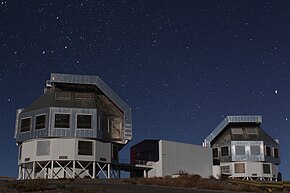Magellan Telescopes
Optical telescopes located at Las Campanas Observatory in Chile From Wikipedia, the free encyclopedia
Optical telescopes located at Las Campanas Observatory in Chile From Wikipedia, the free encyclopedia
The Magellan Telescopes are a pair of 6.5-metre-diameter (21 ft) optical telescopes located at Las Campanas Observatory in Chile. The two telescopes are named after the astronomer Walter Baade and the philanthropist Landon T. Clay. First light for the telescopes was on September 15, 2000 for the Baade, and September 7, 2002 for the Clay. A consortium consisting of the Carnegie Institution for Science, University of Arizona, Harvard University, the University of Michigan and the Massachusetts Institute of Technology built and operate the twin telescopes. The telescopes were named after the sixteenth-century Portuguese explorer Ferdinand Magellan.
 | |
| Alternative names | Walter Baade Magellan 6.5-m telescope (LCO) |
|---|---|
| Named after | Walter Baade, Landon T. Clay |
| Part of | Las Campanas Observatory |
| Location(s) | Atacama Region, Chile |
| Coordinates | 29°00′54″S 70°41′30″W |
| Organization | Carnegie Institution for Science |
| Altitude | 2,516, 2,392 m (8,255, 7,848 ft) |
| First light | 15 September 2001, 7 September 2002 |
| Telescope style | Gregorian telescope optical telescope |
| Number of telescopes | 2 |
| Diameter | 6.5 m (21 ft 4 in) |
| | |
The Giant Magellan Telescope (GMT) is an extremely large telescope under construction, as part of the US Extremely Large Telescope Program.[1]
Baade telescope:
Clay telescope:
This program is a survey of stars searching for planets using the MIKE echelle spectrograph mounted on the 6.5 m Magellan II (Clay) telescope.[2][3]
In 2013, Clay (Magellan II) was equipped with an adaptive secondary mirror called MagAO which allowed it to take the sharpest visible-light images to date, capable of resolving objects 0.02 arcseconds across—equivalent to a dime (1.8 cm) seen from 100 miles (160 km) away.[4]
MagAO was originally intended for the Large Binocular Telescope (LBT), but the secondary mirror was damaged before it could be installed. The project leader Laird Close and his team were able to repair and repurpose the broken mirror for use on Magellan II. As built for the LBT, the original MagAO mirror had a diameter of 36 inches (0.91 m). However, the edge of the mirror was broken. Technicians at Steward Observatory were able to cut the mirror to 33.5 inches (0.85 m) in diameter, thereby removing the broken edge.[5]

Seamless Wikipedia browsing. On steroids.
Every time you click a link to Wikipedia, Wiktionary or Wikiquote in your browser's search results, it will show the modern Wikiwand interface.
Wikiwand extension is a five stars, simple, with minimum permission required to keep your browsing private, safe and transparent.